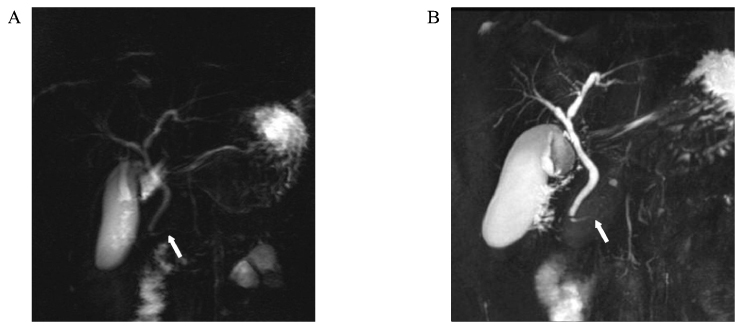J Korean Endocr Soc.
2010 Mar;25(1):78-83. 10.3803/jkes.2010.25.1.78.
A Case of Complete Agenesis of the Dorsal Pancreas in a Patient with Newly Diagnosed Diabetes Mellitus
- Affiliations
-
- 1Department of Internal Medicine, Eulji University College of Medicine, Korea.
- 2Department of Internal Medicine, Konyang University College of Medicine, Korea.
- KMID: 2177868
- DOI: http://doi.org/10.3803/jkes.2010.25.1.78
Abstract
- Agenesis of the dorsal pancreas is a rare congenital anomaly caused by underdevelopment or agenesis of the dorsal pancreatic bud that forms the upper head, neck, body and tail of the pancreas. We report a case of agenesis of the dorsal pancreas, which was found under examination of diabetes mellitus (DM). A 16-year-old girl was transferred to our hospital because of a positive urine glucose reading during a school-conducted examination. Abdominal computed tomography and magnetic resonance cholangiopancreatography revealed the deficit of the pancreatic body and tail. Diabetes-associated autoimmune antibodies were negative in a blood test. Decreased beta-cell function was demonstrated by oral glucose tolerance and glucagon stimulation tests. Although the notion that agenesis of the dorsal pancreas leads to decreased endocrine or exocrine function is controversial, the results of this study suggest that we should consider these causes of diabetes mellitus. When treating a young patient with diabetes mellitus, we should consider causes of diabetes mellitus such as congenital anomaly or maturity onset diabetes, in addition to type 1 and type 2 diabetes mellitus.
MeSH Terms
Figure
Reference
-
1. Kozu T, Suda K, Toki F. Pancreatic development and anatomical variation. Gastrointest Endosc Clin N Am. 1995. 5:1–30.2. Wittingen J, Frey CF. Islet concentration in the head, body, tail and uncinate process of the pancreas. Ann Surg. 1974. 179:412–414.3. Lechner GW, Read RC. Agenesis of the dorsal pancreas in an adult diabetic presenting with duodenal ileus. Ann Surg. 1966. 163:311–314.4. Choi ES, Rhee EJ, Kim JH, Won JC, Park CY, Lee WY, Oh KW, Park SW, Kim SW. Insulin sensitivity and insulin secretion determined by homeostasis model assessment and future risk of diabetes mellitus in Korean Men. Korean Diabetes J. 2008. 32:498–505.5. Wang T, Xiao XH, Li WH, Wang H, Sun Q, Yuan T, Yang GH. Effects of glucagon on islet beta cell function in patients with diabetes mellitus. Chin Med Sci J. 2008. 23:117–120.6. Greenbaum CJ, Mandrup-Poulsen T, McGee PF, Battelino T, Haastert B, Ludvigsson J, Pozzilli P, Lachin JM, Kolb H. Type 1 Diabetes Trial Net Research Group. European C-Peptide Trial Study Group. Mixed-meal tolerance test versus glucagon stimulation test for the assessment of beta-cell function in therapeutic trials in type 1 diabetes. Diabetes Care. 2008. 31:1966–1971.7. Tung YC, Lee JS, Tsai WY, Hsiao PH. Evaluation of beta-cell function in diabetic Taiwanese children using a 6-min glucagon test. Eur J Pediatr. 2008. 167:801–805.8. Kamisawa T, Tu Y, Egawa N, Tsuruta K, Okamoto A, Kamata N. MRCP of congenital pancreaticobiliary malformation. Abdom Imaging. 2007. 32:129–133.9. Schnedl WJ, Piswanger-Soelkner C, Wallner SJ, Reittner P, Krause R, Lipp RW, Hohmeier HE. Agenesis of the dorsal pancreas and associated diseases. Dig Dis Sci. 2008. 54:481–487.10. Kim SJ, Han BH, Jung HJ, You HJ, Yang SW, Park SY, Lee SU. A case of complete agenesis of the dorsal pancreas. Korean J Gastrointest Endosc. 2008. 36:252–256.11. Park WS, Yang KH, Kang SJ, Kim BK, Kim SM. Agenesis of the dorsal pancreas: an autopsy case. Korean J Pathol. 1992. 26:71–75.12. Park SH, Roe IH, Lee MI, Yun SY, Tak WT, Yoo K, Kim JT. A case of complete agenesis of dorsal pancreas. Korean J Gastrointest Endosc. 2000. 20:227–230.13. Oldenburg B, van Leeuwen MS, van Berge Henegouwen GP, Koningsberger JC. Pancreatitis and agenesis of the dorsal pancreas. Eur J Gastroenterol Hepatol. 1998. 10:887–889.14. Edsbagge J, Johansson JK, Esni F, Luo Y, Radice GL, Semb H. Vascular function and sphingosine-1-phosphate regulate development of the dorsal pancreatic mesenchyme. Development. 2005. 132:1085–1092.15. Haumaitre C, Barbacci E, Jenny M, Ott MO, Gradwohl G, Cereghini S. Lack of TCF2/vHNF1 in mice leads to pancreas agenesis. Proc Natl Acad Sci U S A. 2005. 102:1490–1495.16. Slezak LA, Andersen DK. Pancreatic resection: effects on glucose metabolism. World J Surg. 2001. 25:452–460.17. Altman DF. Changes in gastrointestinal, pancreatic, biliary, and hepatic function with aging. Gastroenterol Clin North Am. 1990. 19:227–234.18. Kahn SE, Carr DB, Faulenbach MV, Utzschneider KM. An examination of beta-cell function measures and their potential use for estimating beta-cell mass. Diabetes Obes Metab. 2008. 10:63–76.
- Full Text Links
- Actions
-
Cited
- CITED
-
- Close
- Share
- Similar articles
-
- A Case of Complete Agenesis of Dorsal Pancreas
- A Case of Complete Agenesis of the Dorsal Pancreas with Left Renal Agenesis and Absence of the Left Vertebral Pedicle in T12
- A Case of Partial Agenesis of Dorsal Panacreas
- Agenesis of the Dorsal Pancreas: An autopsy case
- Agenesis of the Dorsal Pancreas: A Case Report and Review of the Literature




